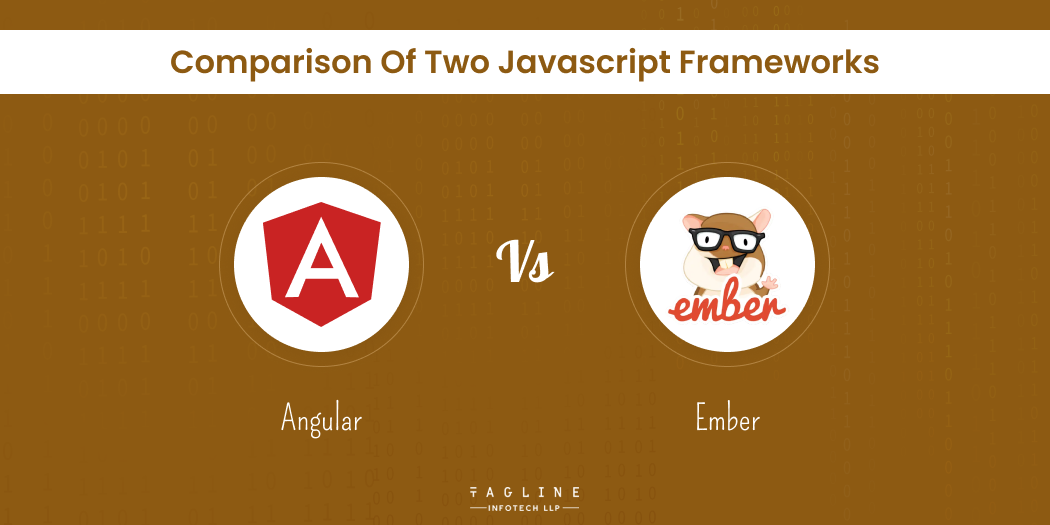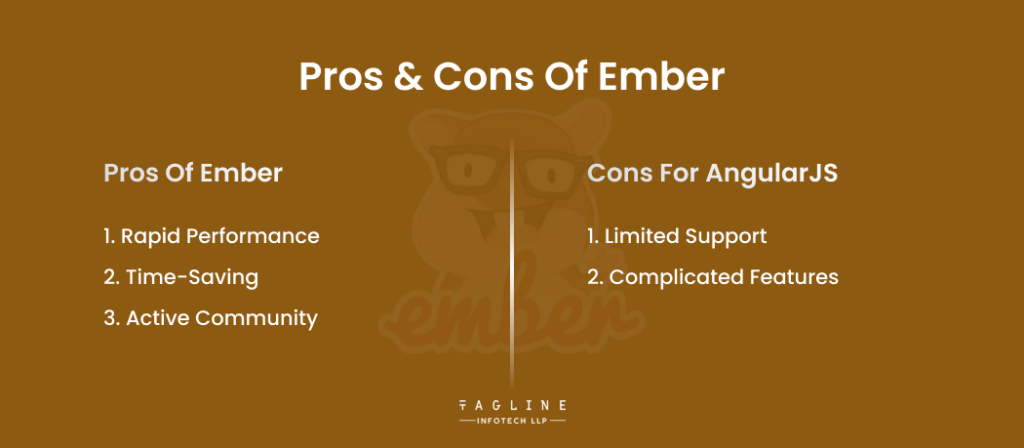A List of The 25 Best Ruby on...
May 8, 2024
Home >> AngularJS >> Angular vs Emberjs: Comparison of two javascript frameworks

Quick Summary
Ember.js is an open-source client-side JavaScript framework based on the MVVM architecture. It is employed in the creation of reusable and easily maintained JavaScript web applications. It enables the creation of client-side JavaScript applications by offering a complete solution that takes data management and application flow into consideration. The project AngularJS is open source and free. JavaScript is the foundation of the very successful front-end web application framework known as AngularJS. It is applied in the context of single-page application projects. To accomplish this, it expands the HTML Data object paradigm, adding new features and enhancing responsiveness to user actions.
A popular open-source JavaScript framework called AngularJS was created to create dynamic web apps. While Google was the firm in charge of its design in 2009, Miško Hevery was the one who wrote the first draft of Angular. It is built using the Model-View-Controller (MVC) pattern.
By using this framework, developers may simplify the development process, provide code that can be reused, and enhance the user interface. AngularJS is comprised of several features that rely on directives, services, dependency injection, and two-way data binding.
Furthermore, it offers strong testing capabilities and an extensive set of AngularJS development tools for application development and debugging. All things considered, AngularJS is a robust and versatile framework for the JavaScript programming language that has gained a lot of traction among developers.

Here is the list of pros for Angular JS:
One of the main advantages of AngularJS over other frameworks is its feature that supports bidirectional data binding. Any changes made to the model will be reflected in the view and vice versa thanks to this capability. This means that managing data synchronization doesn’t need developers to create extra code.
The vast developer community of AngularJS is among the most important contributors to its development, documentation, and support. Because of its vibrant community, which keeps it up to date with the latest trends and best practices, AngularJS is an excellent choice for projects that will be running for a long time.
AngularJS makes use of the Model-View-Controller (MVC) architecture. The program is divided into three distinct components by this architecture. This design pattern makes it easier to maintain projects that are deemed complex by breaking the codebase up into smaller, more manageable components.
For those who are just starting, AngularJS may be challenging to understand due to its steep learning curve. To work with AngularJS efficiently, developers must possess a firm grasp of the syntax and concepts of HTML, CSS, and JavaScript.
“Why Should You Choose AngularJS For Web App Development “
– Also Read Article
Though Yehuda Katz is credited with the original concept, the framework that is currently known as Ember was originally called SproutCore 2.0. When Ember.js was first made available in 2011, it already had over 20,000 stars on the GitHub site. With the use of this technology, user interfaces for any size project—from small single-page applications (SPAs) to large-scale corporate projects—can be built that are both dynamic and captivating.
With the help of the HTML and CSS-based Ember.js development model, programmers were able to quickly gain a thorough understanding of the topic and its ramifications. The functionality of this specific component-based Javascript framework depends on the Handlebars templating engine.
There are several advantages to using Handlebars, one of which is that the templates adapt to modifications to the data automatically. Two further important aspects are the user-friendly application programming interface (API) with extra add-ons and the Ember Inspector, which is used for debugging.

Ember.js has been praised by reviewers for its blazingly quick performance, with many asserting that it makes it possible for their web apps to run smoothly and efficiently.
Ember.js’s organized structure and time-saving features are highly appreciated by users, as they offer precise guidance on where various elements of code should be placed. Time-saving features are among the other features. This organization helps developers save time by managing a large percentage of the wiring required for the building of web applications automatically.
Users of Ember.js hold the community in the highest regard, calling it amazing and motivating. The community also gets information regularly. Furthermore, they mention that the framework is often updated with new features and has extensive documentation.
The community surrounding Ember.js is rather limited when compared to similar frameworks like React.js or Angular, which has led some users to voice their worries about the lack of community assistance. The limited size of the community might result in fewer resources being offered and perhaps even less support for creators.
Some users have complained that creating complex features or interactions might be challenging due to the rigidity of the Ember.js framework. It is a problem that other users have reported. This might need further work and the use of workarounds to get the desired functionality.
Choose between Angular and Ember.js for your needs! Seeking expert help?
Consider hiring a skilled developer to navigate the complexities of support!
Have a look at the pointers for comparing Angular and Ember JS
In terms of technology, Angular and Ember are both made up of difficult instructional scenarios. To gain a thorough understanding of Angular and Ember, especially for novices, could be challenging. However, Angular might be a little easier to register for during the initial enrollment procedure than the Ember framework.
Programmers have more freedom with Angular than with Ember because it permits reliance on external resources. For this reason, Angular is the recommended option. Nevertheless, Ember has strict usage guidelines, which could be a drawback for people who are new to the industry and are attempting to become authorities on the framework.
If you are interested in creating a single-page application with high-performance capabilities, AngularJS is a better option. Unlike Ember, it is a more competent framework to utilize for single-page application (SPA) apps because it does not rely on Javascript or JQuery.
Without a doubt, Ember is also highly popular. As a result, a lot of well-known websites rely on Ember because of its modern features, like Linkedin, and Twitch.tv, Live Nation, and others. Most of the time, it’s also a great option for duties that are comparable to those of SPAs; nevertheless, building desktop applications with Ember is far more recommended.
The testing support offered by Angular JS has been exceptional since its initial release. Because of this, Angular made it incredibly easy for programmers to develop code and conduct testing through the simple usage of dependency injection. Angular has created test runners like Protector to perform the end-to-end testing processes.
Ember’s original introduction fell short of its aim of offering a compelling testing mechanism. But things had improved by the time this issue was resolved, and it now offers first-rate testing support. even though it is impossible to say which test results are favored. As a result, we may determine that Angular is the better choice when contrasting its testing procedure with Ember’s.
Angular contains the component known as Directives. Directives are seen to be the more potent part when compared to Ember. With AngularJS, creating reusable HTML syntax that aids in the formative use of code semantics is a straightforward process. As a result, Angular provides a more thorough method for handling components than Ember does.
Ember components are provided with an approach based on widgets. As such, the Handlebars style has greatly simplified the process of putting HTML tags together. Using this technique makes it easier to create HTML tags that are tailored to a particular application. HTML can also be divided into multiple smaller pieces in addition to that.
The modular concept is followed and utilized by the Angular JS framework. This suggests that the modules that are part of the framework are employed to manage comprehensible code and to decouple services. Two of the most widely used modules that are available with Angular are the Controller and Application modules.
The Ember JS framework, on the other hand, deviates from the traditional modular approach. Its operation depends on the Router, modules, and templates. These elements are used in many different procedures, including those that are necessary for building web applications.
As previously said, creating robust single-page applications is one of the most popular uses for the Angular JS framework. However, it can also be applied to the development of a variety of web applications. This is because Angular has numerous practical features, like support for AJAX, dependency injection, two-way binding, API handling, and many more.
Ember, on the other hand, is widely used for many different web design and software development activities. It’s extremely impressive that Ember can even be used to create complex mobile applications. A multitude of websites, like LinkedIn and Discourse, among others, heavily use the Ember framework.
The frameworks for Ember JS and Angular JS both enable two-way binding. Conversely, the first one can also facilitate one-way data binding. Based on the evidence provided, it can be said that in terms of data binding, the Angular JS framework performs noticeably better than the Ember JS framework.
Angular’s ability to handle both one-way and two-way binding makes it easier to build feature-rich, cross-platform web applications. As a result, many developers tend to prefer the Angular JS framework over Ember frameworks.
Two of the most important differences between the Ember JS framework and the Angular JS framework are their dependencies. The Angular JavaScript framework does not contain any particular kind of dependency.
Nevertheless, it is still capable of handling web app functionalities. On the other hand, for the Ember JS framework to work correctly, it needs both Handlebars and jQuery.
This article has examined the features and similarities of two popular front-end frameworks: AngularJS and EmberJS. Here, one is a traditional framework toolkit, and the other is an entirely original concept. Without a doubt, both of these concepts apply to deep learning resources; however, AngularJS is much easier to get started with, especially if you are not very familiar with JS.
There is very little chance that you will run across problems if you decide to use AngularJS. When developing web apps and projects that are similar to SPAs, it is advised that you use AngularJS instead of EmberJS if you want to avoid the complexity that comes with the development process. To simplify your development journey, consider getting in touch with an Angular.js Development Company for seamless assistance.
Nowadays you can see that EmberJs is still being used by popular companies like Apple Music, Intercom, Groupon, LinkedIn, Twitch, Nordstrom, and many more.
Yes, Angular is better than Ember because it is a lightweight framework that is perfect for small projects. Ember is not preferable because it overcomplicates the app and makes it low-performing in the process of debugging.

Digital Valley, 423, Apple Square, beside Lajamni Chowk, Mota Varachha, Surat, Gujarat 394101
+91 9913 808 2851133 Sampley Ln Leander, Texas, 78641
52 Godalming Avenue, wallington, London - SM6 8NW